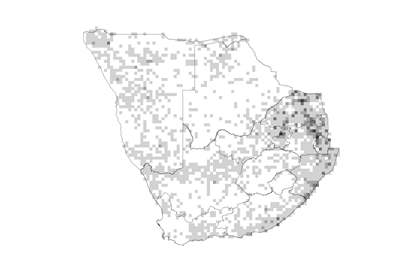 Species distribution and density. Darker squares represent higher density of members of this family. |
Introduction
Pistol bush family
A diverse family of mostly annual or perennial herbs and shrubs, often spiny, with variously coloured and shaped flowers; well known as garden plants.
Distribution
Occurring in tropical and subtropical regions; seldom found in temperate areas. In southern Africa the highest diversity is in the northeastern parts with relatively high summer-rainfall.
Number of genera in the world
ca. 350
Number of species in the world
ca. 4 350
Number of genera in the Flora of southern Africa region
43
Number of species in the Flora of southern Africa region
373
Well-known southern African genera
Barleria, Duvernoia, Thunbergia
Growth forms
Herbs, shrublets, shrubs and sometimes climbers or small trees.
Habitats
Found from forest to arid regions.
Flagship species
Duvernoia adhatodoides (pistol bush; pistoolbos [A]; isipheka [X]; lothabe [Z]) is a shrub or small tree found naturally in forests and along forest margins in the eastern parts of South Africa and Swaziland. The common name is derived from the fact that the fruits burst open with a loud explosive sound. It is a popular garden plant with compact sprays of flowers borne in the leaf axils during late summer. The heartwood is yellow, heavy and attractive and can be used to make small ornaments.
Significance of the family
Many species are cultivated as garden ornamentals (Barleria, Justicia, Thunbergia) or as plants to attract moths, butterflies, honeybees and wasps to city gardens (Asystasia, Hypoestes, Isoglossa). The family has limited local medicinal use as treatment for coughs, diarrhoea and fevers. An Adhatoda species is reportedly used to treat biliousness, while Justicia capensis is traditionally used to attract customers or improve chances of employment. Some members of the family are browsed by game and livestock (Barleria, Justicia, Monechma).
Diagnostic characters
Nodes often swollen. Leaves opposite , sometimes whorled, without stipules and usually with cystoliths in the epidermis. Bracts and bracteoles subtending individual flowers conspicuous, often coloured, large, leafy or sometimes spiny . Flowers borne in leaf axils or tight, terminal spike-like inflorescences. Flowers irregular (1- or 2-lipped) or nearly regular , with fused petals . Ovary superior with two locules. Fruit an explosive club-shaped capsule with seeds mostly borne on hook-like outgrowths . Testa of some genera covered with hairs that become slimy on wetting.
Did you know?
The leaves of the genus *Acanthus were the inspiration for the motif on the capital of Corinthian columns in Greek temples.